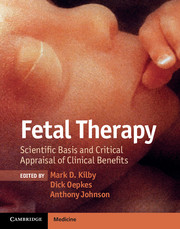Book contents
- Frontmatter
- Contents
- Contributors
- Foreword
- Preface
- Section 1 General principles
- Section 2 Fetal disease
- Chapter 6 Red cell alloimmunization
- Chapter 7 Fetal and neonatal alloimmune thrombocytopenia
- Chapter 8.1 Fetal dysrhythmias
- Chapter 8.2 Fetal dysrhythmias
- Chapter 9.1 Structural heart disease
- Chapter 9.2 Structural heart disease
- Chapter 9.3 Structural heart disease
- Chapter 10.1 Manipulation of amniotic fluid volume
- Chapter 10.2 Manipulation of amniotic fluid volume
- Chapter 11.1 Twin-to-twin transfusion syndrome
- Chapter 11.2 Twin-to-twin transfusion syndrome
- Chapter 11.3 Twin-to-twin transfusion syndrome
- Chapter 11.4 Twin-to-twin transfusion syndrome
- Chapter 11.5 Twin-to-twin transfusion syndrome
- Chapter 12.1 Twin reversed arterial perfusion (TRAP) sequence
- Chapter 12.2 Twin reversed arterial perfusion (TRAP) sequence
- Chapter 13.1 Fetal infections
- Chapter 13.2 Fetal infections
- Chapter 14.1 Fetal urinary tract obstruction
- Chapter 14.2 Fetal urinary tract obstruction
- Chapter 14.3 Fetal urinary tract obstruction
- Chapter 14.4 Fetal urinary tract obstruction
- 15.1 Fetal lung growth, development, and lung fluid
- Chapter 15.2 Fetal lung growth, development, and lung fluid
- Chapter 16.1 Neural tube defects
- Chapter 16.2 Neural tube defects
- Chapter 17.1 Fetal tumors
- Chapter 17.2 Fetal tumors
- Chapter 18.1 Intrauterine growth restriction
- Chapter 18.2 Intrauterine growth restriction
- Chapter 19.1 Congenital diaphragmatic hernia
- Chapter 19.2 Congenital diaphragmatic hernia
- Chapter 20.1 Fetal stem cell transplantation
- Chapter 20.2 Fetal stem cell transplantation
- Chapter 20.3 Fetal stem cell transplantation
- Chapter 21 Gene therapy
- Chapter 22 The future
- Glossary
- Index
- References
Chapter 16.2 - Neural tube defects
Clinical management
from Section 2 - Fetal disease
Published online by Cambridge University Press: 05 February 2013
- Frontmatter
- Contents
- Contributors
- Foreword
- Preface
- Section 1 General principles
- Section 2 Fetal disease
- Chapter 6 Red cell alloimmunization
- Chapter 7 Fetal and neonatal alloimmune thrombocytopenia
- Chapter 8.1 Fetal dysrhythmias
- Chapter 8.2 Fetal dysrhythmias
- Chapter 9.1 Structural heart disease
- Chapter 9.2 Structural heart disease
- Chapter 9.3 Structural heart disease
- Chapter 10.1 Manipulation of amniotic fluid volume
- Chapter 10.2 Manipulation of amniotic fluid volume
- Chapter 11.1 Twin-to-twin transfusion syndrome
- Chapter 11.2 Twin-to-twin transfusion syndrome
- Chapter 11.3 Twin-to-twin transfusion syndrome
- Chapter 11.4 Twin-to-twin transfusion syndrome
- Chapter 11.5 Twin-to-twin transfusion syndrome
- Chapter 12.1 Twin reversed arterial perfusion (TRAP) sequence
- Chapter 12.2 Twin reversed arterial perfusion (TRAP) sequence
- Chapter 13.1 Fetal infections
- Chapter 13.2 Fetal infections
- Chapter 14.1 Fetal urinary tract obstruction
- Chapter 14.2 Fetal urinary tract obstruction
- Chapter 14.3 Fetal urinary tract obstruction
- Chapter 14.4 Fetal urinary tract obstruction
- 15.1 Fetal lung growth, development, and lung fluid
- Chapter 15.2 Fetal lung growth, development, and lung fluid
- Chapter 16.1 Neural tube defects
- Chapter 16.2 Neural tube defects
- Chapter 17.1 Fetal tumors
- Chapter 17.2 Fetal tumors
- Chapter 18.1 Intrauterine growth restriction
- Chapter 18.2 Intrauterine growth restriction
- Chapter 19.1 Congenital diaphragmatic hernia
- Chapter 19.2 Congenital diaphragmatic hernia
- Chapter 20.1 Fetal stem cell transplantation
- Chapter 20.2 Fetal stem cell transplantation
- Chapter 20.3 Fetal stem cell transplantation
- Chapter 21 Gene therapy
- Chapter 22 The future
- Glossary
- Index
- References
Summary
Introduction
Despite advances in prevention, diagnosis, and treatment, neural tube defects (NTDs) remain a major source of morbidity and mortality in the United States and throughout the world. Daily consumption of 400 µg of folic acid before conception dramatically reduced the occurrence of NTDs, but prior to the institution of food fortification, only 29% of reproductive-aged women in the United States were taking a supplement containing this amount [1]. Although routine cereal grain fortification has resulted in a 19% decrease in prevalence, the prevalence values per 10 000 births remain 4.18, 3.37, and 2.90 respectively for Hispanic, non-Hispanic white, and non-Hispanic black women [2]. It is estimated that 23% of pregnancies in which the fetus is diagnosed with an NTD end in elective termination, but the remainder ultimately are delivered. Furthermore, the prenatal management of spina bifida differs depending on the country: as a rule, there is more support for aggressive and intensive treatment in Asia and some regions of the United States than in Europe, although immigration patterns may be changing this.
Although folate supplementation and advances in care may be decreasing the mortality associated with spina bifida, the 5-year mortality remains 79 per 1000 spina bifida births [3]. The mortality is as high as 35% among those with symptoms of brainstem dysfunction secondary to the Chiari II malformation [4]. In addition to sphincter dysfunction and lower extremity paralysis, 81% of affected children have hydrocephalus requiring treatment [5]. Although newer techniques are available for the treatment of hydrocephalus such as endoscopic third ventriculostomy and choroid plexus cauterization, these are not particularly effective in the infant with myelomeningocele, and shunts with all of their problems remain the mainstay of treatment. Roughly 70% of affected individuals have an IQ above 80, but only 37% are able to live independently as adults and one-third need daily care [6]. The economic cost of caring for these patients is large. A recent estimate of incremental direct medical costs for the first year of life for a child with spina bifida compared with those without was $52415 for the first year of life and $560000 for the lifetime in 2003 dollars [7, 8].
Keywords
- Type
- Chapter
- Information
- Fetal TherapyScientific Basis and Critical Appraisal of Clinical Benefits, pp. 311 - 319Publisher: Cambridge University PressPrint publication year: 2012



